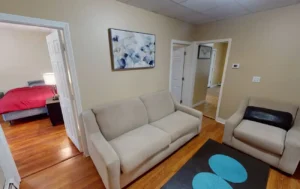

They offer a higher level of focus on social support, giving you someone to talk to and help you. They also provide the same types of services most sober homes do, such as helping you to make it to 12-step meetings and teaching you life skills. Also like other sober-living environments, halfway houses generally have systems in place to keep residents sober, and drugs tests are usually administered to monitor for any substance use.

For people in recovery, it usually refers to sober living homes that provide varying degrees of support and supervision. The structured environment of halfway houses usually includes support staff like a house manager and medical and mental health professionals. The presence of supportive staff, coupled with residents who are also in a similar stage of their recovery, helps a person develop life and social skills to better cope with the reintegration into society. A halfway house is a community-based accommodation that aims to provide a safe and structured environment for those in recovery from alcohol or substance use. Residents of halfway houses are most often transitioning from an inpatient rehab center or incarceration with the completion of a substance treatment program. However, most halfway homes have the goal of supporting you to recovery through a structured environment.
Some halfway houses offer programs such as education and job training to help residents successfully transition back into society. Other halfway houses may be only a residence https://ecosoberhouse.com/article/drug-use-in-sports-risks-you-have-to-know/ for those committed to recovery and provide transportation to and from day programs. There are several types of recovery residences, the most common being a peer-run organization.
They also often come with additional mental health, medical, recovery or educational services that help people get accustomed to their new lives. A halfway house serves as an environment to bridge a completed rehab or substance use treatment program to regular life, allowing a person to reintegrate into society functionally. They offer a safe space and time away from typical triggers of addiction while providing connections to additional resources and services to promote long-term recovery. Both halfway houses and sober living homes offer people in recovery a soft place to land. At these facilities, we begin learning useful skills, forging new bonds, and rebuilding our life. Whichever housing solution we choose, we’ll be ready to handle triggers and cravings as they come — all thanks to the support of our peers in recovery.

The majority were operated by private, nonprofit organizations with boards of directors made up of leaders from the criminal justice, educational, and religious communities, as well as other dedicated citizens. Board members often provided access to recreational, religious, medical, vocational, and transportation services, as well as assistance with obtaining gainful employment. The concept of the halfway house is predicated upon the ideals of humanitarianism, rehabilitation, and reintegration.
In short, sober living houses contain all of the “pros” of halfway houses, without most of the “cons”. For example, New Life House provides structure, community, and treatment. New Life what is a halfway house House partners with a local treatment center that offers dual-diagnosis treatment programs. Services include group and individual therapy, psychiatric help, and case management for each client that moves through the program.
Once occupied, a cell was in the range of $20,000 to $25,000 annually to operate. At that time, residential beds in the community for individuals exiting prison were, on average, about $12,000 annually. These developments might have been expected to be the death knell for the halfway house movement. However, with jails and prisons becoming increasingly crowded, halfway house programs demonstrated remarkable functional flexibility.

Another common mistake people make is confusing halfway houses with sober living homes. While both offer residents the opportunity to transition back into society, key differences exist between them. The qualifications to live in a halfway house vary depending on the facility.

“Aftercare” is what happens both during and after your initial rehab program. While you’re in rehab, your treatment team is working to make sure you have the skills you need to be successful once you leave. Sober-living homes are usually privately owned and expect residents to pay for rent and utilities just like everywhere else.
Completa i campi per ricevere un preventivo
Descrivi ciò di cui hai bisogno. Il nostro staff prenderà in consegna la tua richiesta e ti risponderò nel minor tempo possibile